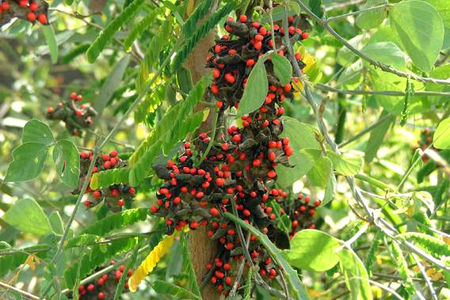Jequirity
Other Names : Abrus precatorius, Crab eyes, Crab's eye, crab's eye creeper, cock's eyes, gwenn légliz, rosary pea, paternoster pea, love pea, precatory pea, precatory bean, kundu mani, Guruvinda ginja, prayer bead, John Crow Bead, coral bead, red-bead vine, country licorice, Indian licorice, wild licorice, Jamaica wild licorice, Akar Saga, coondrimany, gidee gidee, Jumbie bead, ratti/rettee/retty, weather plant, is a slender, perennial climber that twines around trees, shrubs, and hedges. It is a legume with long, pinnate-leafleted leaves.
Contents
Special Precautions of Jequirity
The seeds, which are toxic because of the presence of abrin. Ingestion of a single seed, well chewed, can be fatal to both adults and children
Pharmacological Activities
Antibacterial, Anthelmintic, Antiviral, Anti-inflammatory, Anticancer/ Antitumour, Antiplatelet, Antiprotozoal, Immunomodulatory, Antioxidant, Antiplasmodial, Antitubercular and Molluscicidal.
Health Benefits and uses of Jequirity are
Abrus precatorius has been used in Siddha medicine for centuries.
- The leaves of Abrus precatorius are used with other bush to make a syrup for chronic asthma.
- A decoction of the leaves has been prescribed for scurvy, cough, bronchitis, sprue and hepatitis and as a refrigerant. They are also applied on painful swellings, eye inflammation, cancer, syphilis and on leucodermic spots.
- The white variety is used to prepare oil that is claimed to be an aphrodisiac.
- A tea is made from the leaves and used for fevers, coughs and colds.
- Seeds are poisonous and therefore are used after mitigation. The Tamil Siddhars knew about the toxic effects in plants and suggested various methods which is called "suththi seythal" or purification. This is done by boiling the seeds in milk and then drying them. The protein is denatured when subjected to high temperatures which removes its toxicity.
- The plant is also used in Ayurveda and is said to promote hair growth. It is sometimes used as an ingredient in Indian hair products.
- The seeds are sometimes used in crafts, but this is discouraged because of the toxicity. The seeds are also put in lamps to make the oil last longer.
- One herbalist uses of leaves or the seeds to stop hemorrhage in women. For this remedy the seeds are parched with a dry ochra pod (Abelmoschus esculentus) then boiled with three leaves of lozey (sorrel) (Hibiscus sabdariffa) and some chouvalyé wonzé leaves (Portulaca pilosa), strained, and given to the person to drink. Drink a tea of the flowers to become a duppy man or women. The seeds of this plant contain the phytotoxin abrin, a protein molecule of high toxicity when chewed. It is destroyed by heat.
- An ethanolic extract of Abrus precatorius was found to have antioxidant, anti-inflammatory and analgesic potential in rodents.
- A methanolic extract of A. precatorius seeds causes reversible alterations in the estrous cycle pattern and completely blocked ovulation in Sprague-Dawley rats.
- The methanolic extract produces dose-dependent bronchodilator activity in a guinea pig model.
- Studies on aqueous, methanolic and chloroform extracts of Abrus precatorius showed greater inhibitory activity against a number of disease-causing bacteria such as Bacillus subtilis, Pseudomonas aeruginosa, Staphylococcus aureus, Salmonella typhimurium, and Escherichia coli.
Phytoconstituents
Abrectorin, abricin, abridin, abrins A–D, (+)-abrine, abruslactone A, abrusgenic acid, abrusogenin, abrusoside A–D, precatorine, a bruquinones, a braline, a brusic acid, a bruquinone G and others.
References
- Raamachandran, J. "Herbs of Siddha medicines: The First 3D Book on Herbs", page 2.
- http://www.inchem.org/documents/pims/plant/abruspre.htm#SectionTitle:3.3%20The%20toxin%28s%29
- J. H. Maiden (1889). The useful native plants of Australia : Including Tasmania. Turner and Henderson, Sydney.
- Arora, R.; Gill, N. S.; Kaur, S.; Jain, A. D. (2011). "Phytopharmacological evaluation of ethanolic extract of the seeds of Abrus precatorius linn". Journal of Pharmacology and Toxicology. 6 (6): 580–588. doi:10.3923/jpt.2011.580.588.
- Okoko, I. I.; Osinubi, A. A.; Olabiyi, O. O.; Kusemiju, T. O.; Noronha, C. C.; nlawon, A. O. (2010). * "Antiovulatory and anti-implantation potential of the methanolic extract of seeds of Abrus precatorius in the rat". Endocrine Practice. 16 (4): 554–560. doi:10.4158/ep09011.or.
- Mensah, A. Y.; Bonsu, A. S.; Fleischer, T. C. (2011). "Investigation of the bronchodilator activity of abrus precatorius". Int J Pharm Sci Rev Res. 6 (2): [pp. 9–13].
- Kekuda TR, Vinayaka KS, Soumya KV, Ashwini SK, Kiran R. Antibacterial and antifungal activity of methanolic extract of Abrus pulchellus Wall and Abrus precatorius Linn: A comparative study Archived August 31, 2012, at the Wayback Machine.. Int J Toxicol Pharmacol Res. 2010;2:26–9.
- Sudipta Roy, Rabinarayan Acharya, Narayan C. Mandal,1 Soma Barman, Ranjan Ghosh, and Rajiv Roy. A comparative antibacterial evaluation of raw and processed Guñjā (Abrus precatorius Linn.) seeds. Anc Sci Life. 2012 Jul-Sep; 32(1): 20–23.
